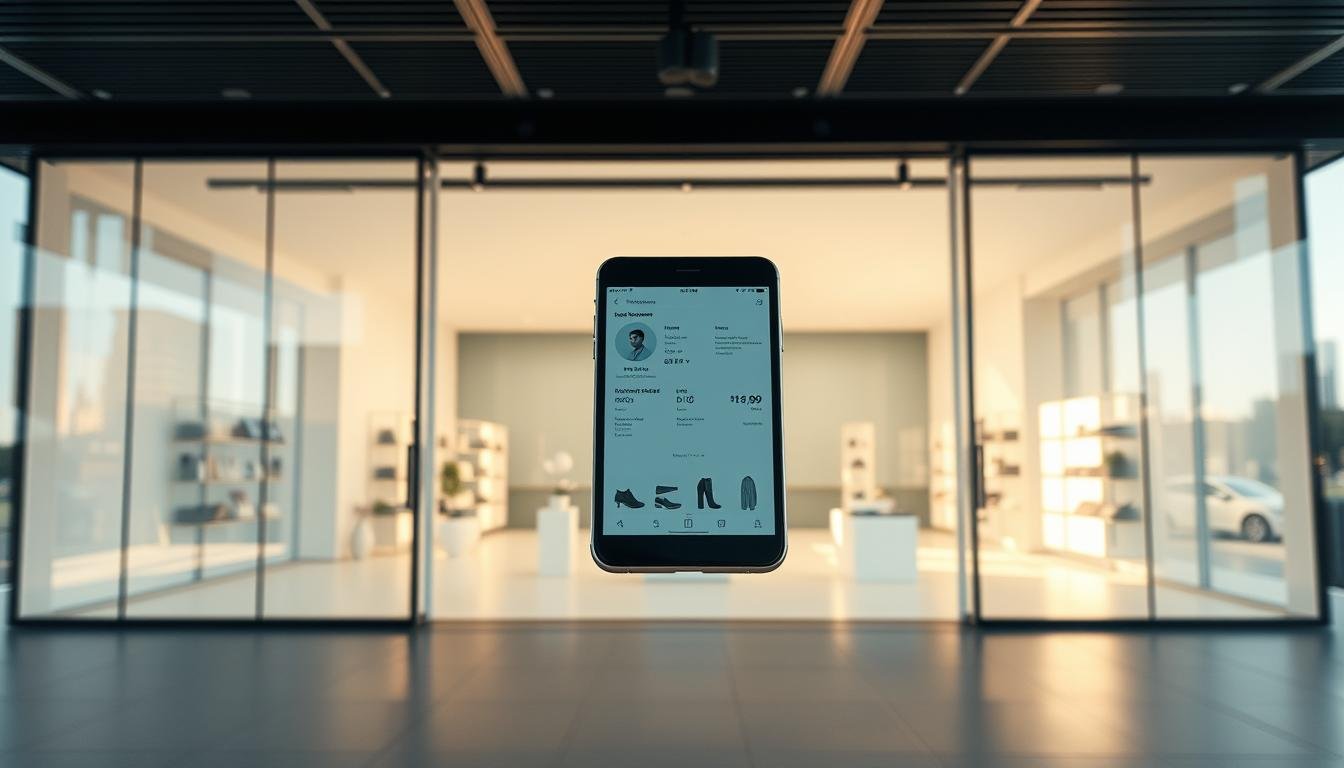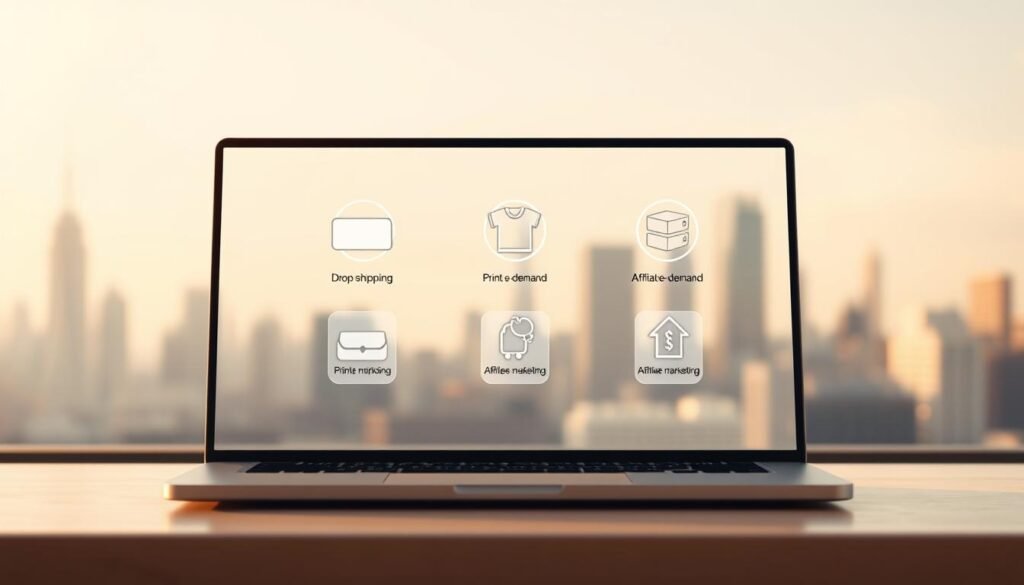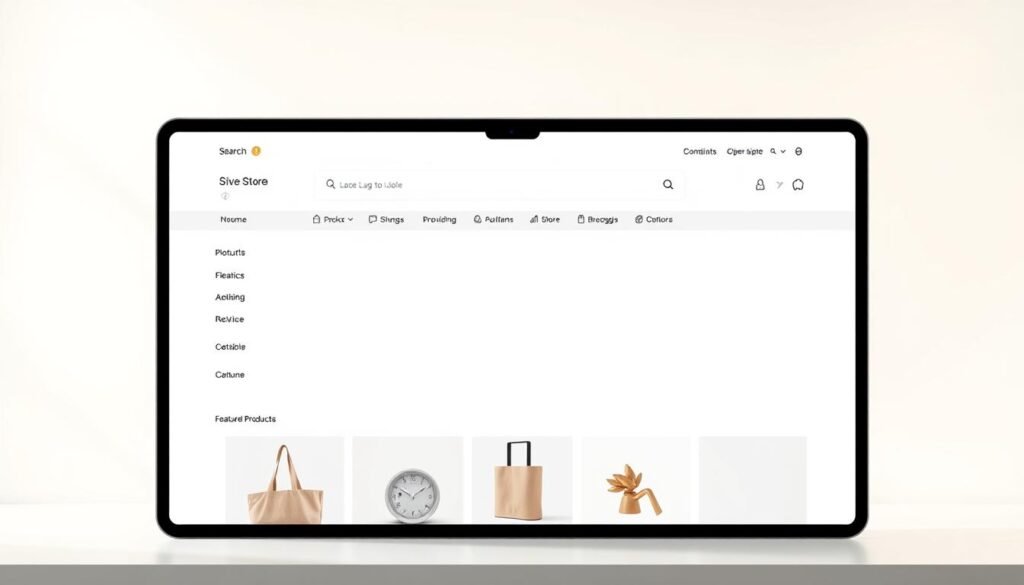Address
304 North Cardinal
St. Dorchester Center, MA 02124
Work Hours
Monday to Friday: 7AM - 7PM
Weekend: 10AM - 5PM
Address
304 North Cardinal
St. Dorchester Center, MA 02124
Work Hours
Monday to Friday: 7AM - 7PM
Weekend: 10AM - 5PM

Imagine running an e-commerce business without the hassle of stock. You can concentrate on marketing and sales while a third-party supplier manages the inventory. This idea, called inventory-less e-commerce, is becoming more popular among entrepreneurs.
You can start your e-commerce journey without spending a lot upfront. By using inventory-free e-commerce, you can test the market, check if your product ideas work, and grow your business fast.
You can start an e-commerce business without keeping any products in stock. This is thanks to partnerships with suppliers. They ship products straight to your customers.
Inventory-free e-commerce means selling online without keeping any stock. You partner with suppliers who handle storage and shipping.
The process is simple:
Running an inventory-free online business has many advantages, including:
By understanding inventory-free e-commerce, you can start or expand your online business smartly.
You can start an e-commerce business without any inventory. Several innovative models make this possible. These models are easy to start and reduce the financial risks of managing inventory.
Dropshipping is a popular model where you sell products without any stock. When a customer orders, the supplier ships the product directly. This model saves you from storing inventory and cuts down on costs.
The main benefits of dropshipping are:
Print on Demand (POD) lets you sell customised products like t-shirts and mugs without stock. The supplier prints and ships the products after a customer orders.
POD’s key advantages are:

Affiliate marketing is about promoting other companies’ products and earning a commission. This model is inventory-free, as you don’t handle any products.
The benefits of affiliate marketing are:
Selling digital products like e-books and online courses is another way to run an inventory-free e-commerce business. Since digital products are intangible, there’s no need for storage or shipping.
The advantages of selling digital products are:
Each model offers a unique way to start and run an e-commerce business without inventory. By understanding each model’s characteristics and benefits, you can choose the best one for your business goals and preferences.
Finding the right niche is key for a successful e-commerce business without stock. It’s about understanding what your audience wants, knowing the market, and doing what you love.
To pick a profitable niche, keep up with market trends. Here’s how:
Knowing your competitors is vital. Here’s what to do:
As an ecommerce expert says, « Knowing your competition is key to finding your niche in the e-commerce market. » It’s a big deal.
Market trends and competitors are important, but passion is key. Running an e-commerce without stock needs commitment. Your love for the niche can drive you.
Why choose a niche you love? It helps in many ways:
By mixing market research, competitor analysis, and passion, you find a niche that’s both profitable and fulfilling.
Creating an online store without inventory is possible. It requires several key steps. These steps make your e-commerce business efficient, easy to use, and ready for sales.
The first step is to pick the right e-commerce platform. Options like Shopify, WooCommerce, and BigCommerce are popular. They offer different features and can grow with your business.
When choosing, think about ease of use, how customizable it is, payment options, and app integrations.
| E-commerce Platform | Key Features | Scalability |
|---|---|---|
| Shopify | Easy product management, multiple payment options | Highly scalable |
| WooCommerce | Highly customizable, integrates with WordPress | Scalable with WordPress |
| BigCommerce | Built-in features for product management, SEO optimization | Scalable with various integrations |
After picking your platform, focus on designing a great website. It should look good and be easy to use. Make sure it works well on mobile devices too.

To run smoothly, your store needs key features. These include secure payment options, product reviews, and customer support. Also, think about adding social media links and newsletter sign-ups.
By choosing the right platform, designing a great website, and adding important features, you can start a successful online store. This setup will help your business grow and reach new markets.
The success of an inventory-free e-commerce business relies on a strong network of reliable suppliers. Starting an e-commerce business without inventory means finding trustworthy suppliers is key.
When looking for suppliers, focus on a few important things. Reliability, product quality, and communication are essential. You need suppliers who deliver quality products on time and keep in touch.
Also, consider their shipping policies, return and refund policies, and product pricing. Make sure their policies match your business and what customers expect.
To vet suppliers, do thorough research and due diligence. First, look for reviews, testimonials, and ratings from other businesses.
Also, ask for references and talk to other businesses that have worked with them. This gives you insight into their reliability and performance.
After finding reliable suppliers, building strong relationships is crucial. Keep in touch regularly, negotiate fair terms, and thank them for their service.
Strong partnerships help your no-inventory business run smoothly. This leads to happier customers and more loyalty.
To succeed in the competitive world of online business without stock, you need a strong marketing plan. Good marketing is key to drawing in and keeping customers. It drives sales and helps your business grow.
Social media is a great way to reach your audience. By making interesting content and using sites like Instagram, Facebook, and Twitter, you can boost your brand. This also helps more people visit your website.
Key social media strategies include:

Email marketing is still a top way to connect with your customers directly. By building an email list and making compelling campaigns, you can show off your products and deals to the right people.
Effective email marketing involves:
Content marketing is about making valuable content to draw in and keep your audience. This can be blog posts, videos, or guides that share useful info about your products.
Successful content marketing strategies include:
In the world of online stores with no inventory, pricing is key to success. You must find a balance between being competitive and making a profit.

First, know all the costs of your products. This includes the product itself, shipping, and other costs like marketing and packaging.
Calculating Total Cost: To set the right price, add the product cost, shipping, and other expenses together.
It’s important to research your competitors. Look at their pricing to get a better understanding of the market.
There are several ways to price your products. These include:
Pick a strategy that fits your business goals and the market.
By knowing your costs, studying competitors, and picking the right pricing, you can set prices that attract customers and boost sales in your dropshipping e-commerce business.
The key to a successful online store without inventory is managing customer expectations. It’s important to know how to talk to your customers well.
Being clear with your customers builds trust. Make sure your website and marketing say when products will arrive, if there will be delays, and other important stuff. Being open helps keep customers happy and avoids disappointment.
If you dropship, tell your customers about shipping times and that the product comes straight from the supplier. This sets the right expectations and makes your business look professional.
Dealing with returns and refunds well is key. Have a clear return and refund policy that’s easy to find on your website. This makes returns less stressful.
It’s also important to quickly answer questions about returns and refunds. Using automated systems to say you’ve got their query and when they’ll hear back can make customers happier.
Building trust is more than just being clear and handling returns well. It’s about being reliable and honest. Always keep your promises, whether it’s about shipping or product quality.
Also, ask customers for reviews and feedback. People often check reviews to see if a business is trustworthy. Answering both good and bad reviews shows you care about what customers say.
By focusing on clear talk, handling returns and refunds well, and building trust, you can manage customer expectations in your online store without inventory.
Your e-commerce success, especially with a zero-inventory model, depends on easy and safe payment options. It’s key to know how payment processing works online.
There are many payment gateways to choose from. PayPal, Stripe, and Square are popular. For example, PayPal is well-known and trusted. Stripe makes it easy to integrate with your online store.
Choosing the right payment gateway is important. You need to think about fees, how easy it is to set up, and customer support. Also, consider what payments you want to accept, like credit cards or Apple Pay.
Transaction fees can really affect your profits, especially if you’re making thin margins. It’s vital to know the fee structures of different gateways and how they impact your business.
Some charge a flat fee per transaction, while others take a percentage of the sale. Work out the total cost of each gateway to find the best one for your business.
Security is crucial when processing payments online. Make sure your chosen gateway meets the Payment Card Industry Data Security Standard (PCI-DSS) to protect customer data.
Choose gateways with advanced security like tokenization and two-factor authentication. These help keep transactions safe and prevent fraud.
By carefully choosing payment gateways, understanding fees, and focusing on security, you can offer a smooth and safe payment experience. This will help your zero-inventory online store succeed.
Understanding your e-commerce business’s performance is key. It helps spot areas for betterment. This is especially true for online stores without stock, as it guides growth.
To get a clear view of your business, track important metrics. These give you insights into how your business runs. Key metrics include:
These metrics show your business’s good and bad points. They help you make smart choices based on data.
Many tools can help monitor your e-commerce business. Some top picks are:
| Tool | Description | Key Features |
|---|---|---|
| Google Analytics | A detailed analytics tool for website traffic and behavior. | Traffic analysis, conversion tracking, audience insights. |
| Shopify Analytics | A built-in analytics tool for Shopify users, offering sales and customer behavior insights. | Sales tracking, customer insights, product performance. |
These tools give you valuable insights. They help you see where to improve.
With data on your business’s performance, you can make smart choices. This means:
By using data to guide your decisions, you can grow your business. This improves its overall performance.
Starting an online store without inventory is a big step. It’s key to plan for growth. Scaling your business means making smart choices to grow. You’ve already started on a path to success with no inventory.
Adding new products is a great way to grow. Look for trends and what customers want. This helps you reach more people and grow your business.
Using new ways to market is important. Try social media, working with influencers, and ads. This keeps you ahead in the online market.
As your business gets bigger, you might need more help. You could hire people for customer service, marketing, or logistics. The right team keeps your business running well.
With these strategies, you can grow your e-commerce business. You’ll find success in the online world.
Inventory-free e-commerce means selling products without keeping any stock. Suppliers ship products directly to customers. This way, you don’t need to store or manage inventory.
You can start without inventory by using dropshipping, print on demand, affiliate marketing, or selling digital products. Each model has its own benefits. Choose the one that best fits your business goals.
Running without inventory saves you money upfront and reduces risk. It also lets you offer more products. This model frees you up to focus on marketing and sales, without worrying about stock.
Look for reliable suppliers by researching their products, shipping, and customer service. Use directories like SaleHoo or AliExpress to find trusted suppliers.
Dropshipping is a model where you partner with a supplier to ship products to customers. You handle marketing and sales, while the supplier takes care of storage and shipping.
To set good prices, know your costs and compare with competitors. Consider demand, market trends, and profit margins. This helps you price your products competitively.
Track website traffic, conversion rates, average order value, and customer retention. Use tools like Google Analytics to monitor your performance. This helps you make informed decisions.
To grow, expand your product range and explore new marketing channels. Consider hiring help when needed. Always keep an eye on your performance and adjust your strategies for growth.
Good payment gateways include PayPal, Stripe, and Square. Look at transaction fees, security, and compatibility with your platform. Choose one that meets your needs.
Manage expectations by being clear with customers, handling returns well, and building trust. Respond quickly to questions and provide accurate product info. This keeps customers happy.